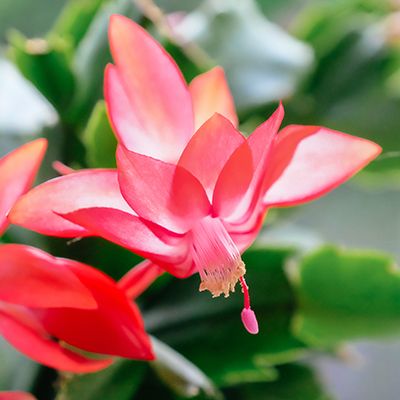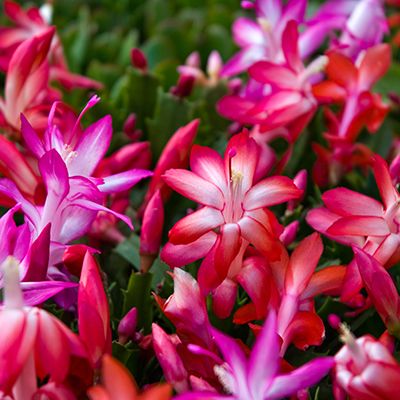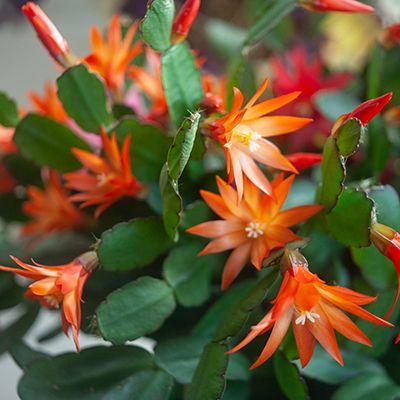


Holiday Cactus
These cacti bloom about the same time as when we celebrate Thanksgiving, Christmas and Easter. Some of the blooming times overlap and so the growers simplified name and refer to them as holiday cacti. All three belong to the same genus, Schlumbergera. They are all native to Brazil and require the same care so names are not a serious problem.
Schlumbergera are short day plants; they need a long, non-interrupted dark period (night) and a low temperature period (50°F or less) in order to bloom. If these conditions are not met, blooming will be delayed or prevented. For the Bay Area gardener, the easiest way to meet these requirements is to grow the plant out of doors in filtered sunlight away from any artificial light source. Once the flower buds start to show, the plant can be placed wherever desired. The holiday cacti can be left out of doors all year round or brought inside when the flower buds start to show. If you hold off too long before bringing the plant indoors (buds one-half of an inch or more long) the buds dry up and fall off.
All of the holiday cacti are epiphytes, that is, in their native environment, they live attached to trees. They gather their nutrients from dust, decayed leaves, dead insects, bird droppings and similar organic matter. Rain is their water source. A good potting medium can be prepared using eight parts Master Nursery® Gardener’s Gold™ Potting Soil, three parts mini-mulch bark and one part perlite. A few tablespoons of Master Nursery® Cottonseed Meal will take care of fertilizer needs for the first six months. After that, you can use 14-14-14 Osmocote® every four months. If the cacti get too much sun, they will bloom well but the foliage will be bleached and less attractive. If they do not get enough sun, they will have fewer blooms. Seldom, mealy bugs may infest the plant. The quickest, easiest cure for mealy bugs is to spray them with undiluted rubbing alcohol. When the mealy bugs turn brown, they are dead.
Thanksgiving cactus or crab cactus (Schlumbergera truncata): Sometimes sold as Zygocactus truncata this cactus will start to bloom about the middle of November and finish about the end of December. Flower color can be orange, pink, red, white or salmon. Each branch is composed of segments (called joints) which are one or two inches long and arranged end to end to form a branch up to three feet long. Each joint has several teeth along each edge with the longest being at the end
of the joint from which it gets its name “crab cactus”. These cacti are prolific bloomers over a prolonged period and the ones most commonly available. They are often sold as “Christmas cacti”.
Christmas cactus (Schlumbergera bridgesii): Start to bloom toward the end of December and finishes by the middle of February. It has only one flower color; a dark pink. Each joint has rounded edges and is about one and one-half inches long and may form a branch about one and one-half feet long. It is a less prolific bloomer than the crab cactus.
The Easter cactus (Schlumbergera gaertneri or Rhipsalidopsis gaertneri): Bloom in April or May and sometimes again in July. Flowers may be red or pink. The joints are one and one-half to two inches
long and have smooth rounded edges. The plant is somewhat upright and may grow as a cluster up to six inches high and one foot wide. This plant should be given protection during cold weather.
Propagation: All of the holiday cacti are easily propagated from one or more of the joints. Burry a joint half way deep in the potting mix described above. A string of four to eight joints may also be used but bury only the first joint. Keep the soil mix moist and in the same location as the mature cacti.